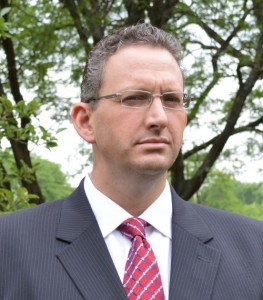 Since the Cleveland Play House’s founding in 1915, it yearned to find a place to call home, establish financial stability and define its mission.
Since the Cleveland Play House’s founding in 1915, it yearned to find a place to call home, establish financial stability and define its mission.
Those challenges are the backbone of America’s First Regional Theatre: The Cleveland Play House and its Search for a Home (Palgrave Studies in Theatre and Performance History, 2014), a new book by Case Western Reserve University author Jeffrey Ullom.
Ullom, an assistant professor of theater, researched 1,300 boxes of Play House archival material—information unavailable to researchers before it was donated to Case Western Reserve’s Kelvin Smith Library in 2011.
Ullom reviewed private board minutes and financial records that revealed near bankruptcies and found public stage photographs, news clippings, programs, advertisements and much more.
“The archives were key to providing insight about the institution’s history, but (the information) also showed its place in the community,” Ullom said.
He also discovered how community support helped the theaters survive hard times and earn distinction as the country’s oldest regional theater.
“The theater’s symbiotic relationship with the city is unlike any other regional theater in the country,” he said.
Ullom traces the theater’s development and how it has reflected the climate in Cleveland through both World Wars, the Depression, suburban flight, racial and social unrest and an evolution of its economic base from manufacturing to health care and entrepreneurial pursuits.
Each impacted whether people attended the theater or not, he said.
Ullom found the Play House took creative ways to connect with the community, such as shifting show times to midnight to accommodate factory workers on second shift in the 1930s. The theater staff also sent messages of support to young actors and theater benefactors in the armed forces during wartime. The theater created educational programs for children to become involved in the theater and develop a young, enthusiastic audience, which in turn, would draw their parents to see productions. The Play House also included more diverse plays to attract minority residents from nearby neighborhoods.
Over time, he said, the community took greater ownership of the theater, which presented both a blessing and a burden to try to satisfy what the community wanted on stage. But it had a cost that artistic and educational theater productions were shelved.
Ullom explains how Raymond O’Neil, the theater’s first director, had hoped to develop artistic productions from which the community could learn—a traditional focus of early regional theater.
But the theater evolved quite differently, Ullom said, because Cleveland audiences wanted familiar plays like A Christmas Carol.
For the theater to find a permanent home required what Ullom calls “a more populist theater.” While most regional theaters sunk in debt, catering to the public kept the Play House afloat.
More involved in founding than first thought
Earlier histories describe how eight people met in 1915 in the living room of Charles and Minerva Brooks at 1589 E. 115th St. to map out a new arts theater. But Ullom discovered more than eight were involved, and that women, in particular, marshaled support from the Suffragettes’ movement.
A barn on Brooks’ property served as the theater’s first home. It provided space to launch O’Neil’s vision of artistic and educational plays. But even then, the founders eyed Euclid Avenue (home to Cleveland’s famed Millionaires’ Row) for a permanent home.
A generous gift from industrialist Francis E. Drury made that possible with his offer of a vacant family home. It would become the Brooks Theater at East 86th Street and Euclid Avenue around 1929. With a few renovations and additions, it served as the theater’s home for 84 years. Later, the Drury Theater in an old church at East 77th Street was added.
Eventually, a complex of a castle-like theater was built at 8500 Euclid, designed by renowned architect Philip Johnson. But the building’s design with large stages wasn’t appropriate for many artistic plays that required smaller stages and smaller seating areas. And, in time, the theater became costly to maintain.
Ullom writes about how, more recently, the Play House again searched for a home, looking downtown or east toward University Circle.
After selling the complex in 2009 to the Cleveland Clinic, the Cleveland Play House opened in the Allen Theatre at Playhouse Square in 2011.
Ullom writes how the theater is positioned to offer artistic and educational plays alongside Broadway productions and other entertainment at Playhouse Square.
So, in that way, the Play House may have come “full circle” and can meet its original founders’ vision.
With what appears to be a permanent home and a fitting mission, Ullom writes that the theater still faces financial challenges that can only be met with community support.
